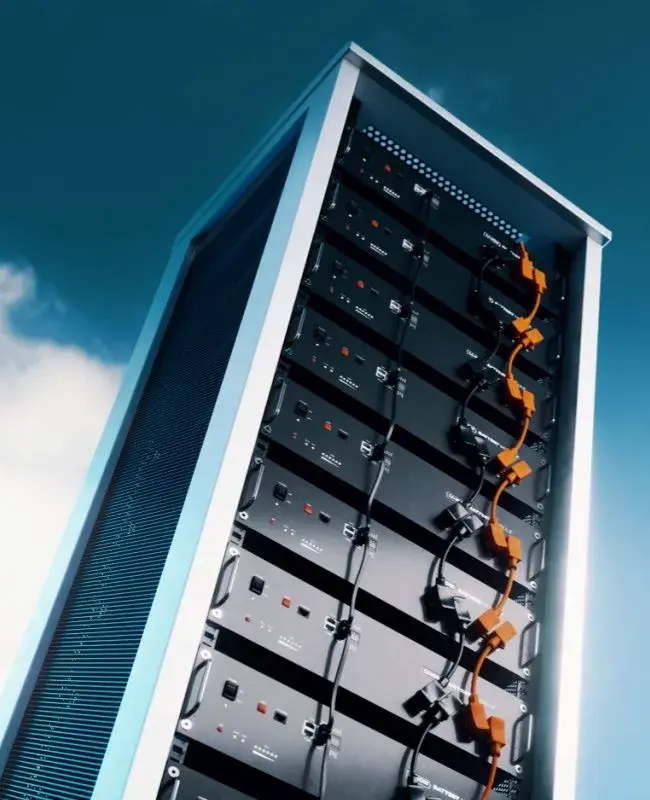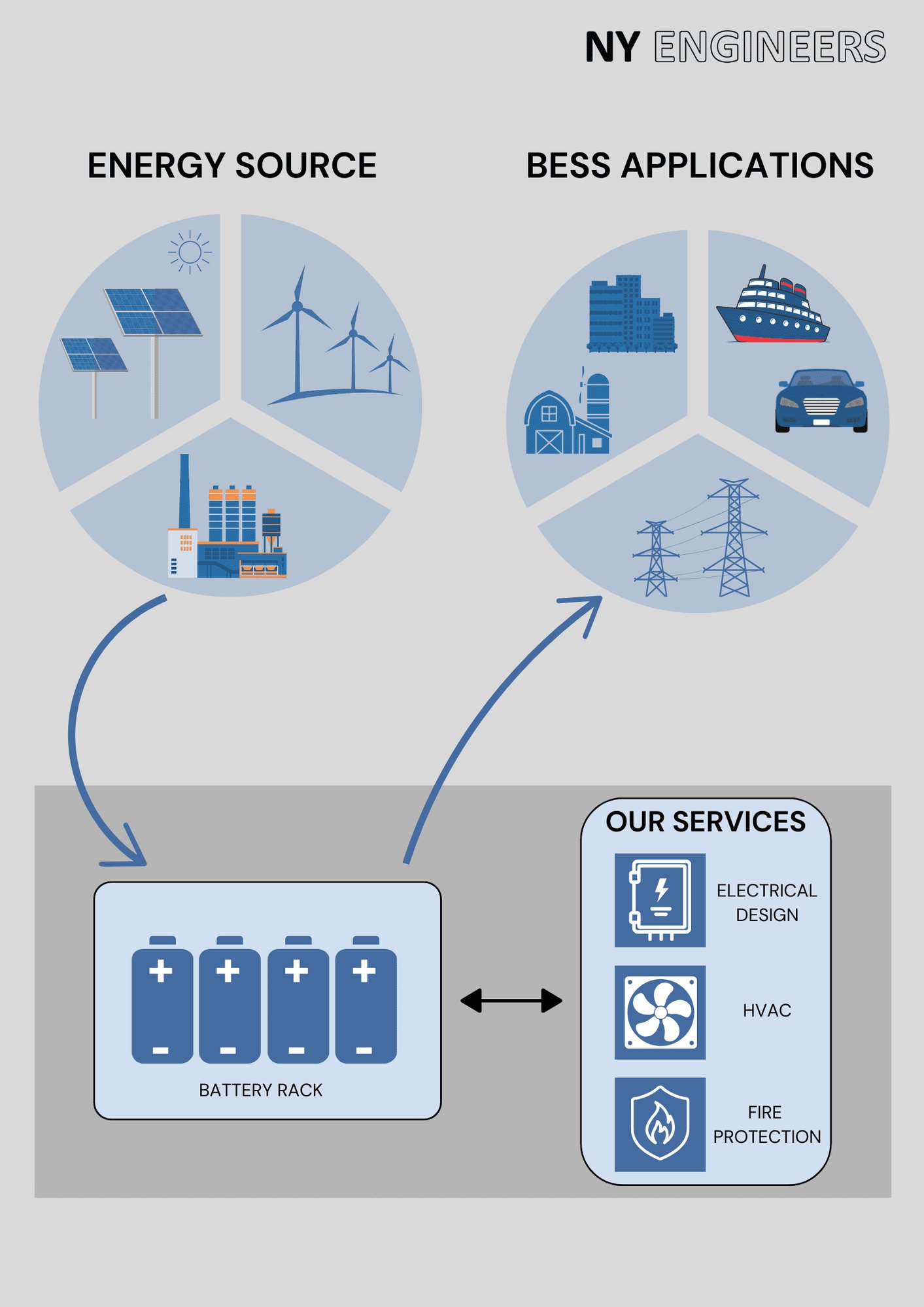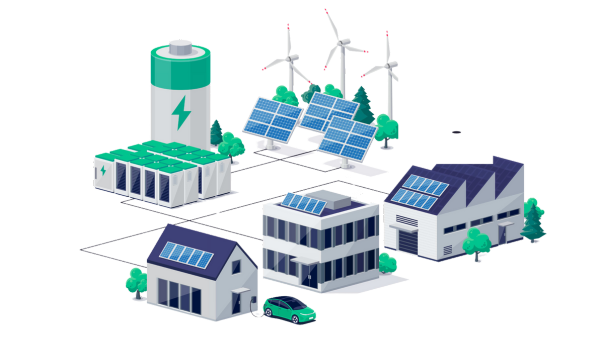
Battery Energy Storage System Design
What do NY Engineers do?
NY Engineers provides the best safety design services for BESS installations. We understand the specific requirements of battery energy storage systems (BESS). Our highly skilled MEP engineers specialize in designing MEP for crucial systems, and we have done multiple projects in the past that will give you the best performance and safety for your BESS operations. We have a list of services that we provide based on your needs and site requirements, which include:
- Heating, Ventilation, and Air Conditioning (HVAC) Design: We design the best HVAC systems and provide a controlled and effective environment for your BESS cabinet and containers. This will improve safety and battery life, prevent overheating at the plant, and ensure high-efficiency operation.
- Electrical services are a vital service when designing BESS. It helps the flow of energy in the proper direction. Especially from panels to batteries and batteries to the power grid. Electrical systems should be designed properly to make sure overheating and loss of energy are avoided.
- Fire Alarm System: It works to prevent smoke, heat, and flames before they affect the components. In BESS design, the fire alarm system is installed in a very precise way so that the batteries will be safe even if the temperature is high inside the system.
- Dry Pipe Sprinkler System Design: Our fire safety specialists will design a dry pipe sprinkler system specifically for BESS. Dry pipe sprinkler systems are preferred over regular water sprinklers, as this will prevent damage and electric breakdown. Even after the fire incident, this will make sure the batteries stored in cabinets are safe.
What is a Battery Energy Storage System (BESS)?
In the industry, Battery Energy Storage System (BESS) technology is widely used to store energy through the use of rechargeable batteries in the system. This system is essentially used in power grid integration for different types of renewable energy sources, for example, wind and solar power.
A BESS is designed by selecting the appropriate battery technology, sizing the system depending on the predicted load profile, and building the power conversion and control systems to ensure efficient operation. Battery chemistry, temperature control, safety features, and connectivity with existing grid infrastructure are all elements to consider in the design of a battery energy storage system. NY Engineers will be your one-stop solution to help you with designing the battery energy storage system.
A battery energy storage system is required for the efficient integration of renewable energy sources into the grid. The design and implementation of the battery energy storage system require careful consideration of different factors to ensure optimal performance and reliability for the system.


In the industry, Battery Energy Storage System (BESS) technology is widely used to store energy through the use of rechargeable batteries in the system. This system is essentially used in power grid integration for different types of renewable energy sources, for example, wind and solar power.
A BESS is designed by selecting the appropriate battery technology, sizing the system depending on the predicted load profile, and building the power conversion and control systems to ensure efficient operation. Battery chemistry, temperature control, safety features, and connectivity with existing grid infrastructure are all elements to consider in the design of a battery energy storage system. NY Engineers will be your one-stop solution to help you with designing the battery energy storage system.
A battery energy storage system is required for the efficient integration of renewable energy sources into the grid. The design and implementation of the battery energy storage system require careful consideration of different factors to ensure optimal performance and reliability for the system.
How does a battery energy storage system work?

The battery energy storage system's prime duty is to collect energy from different sources and store it in rechargeable batteries for later use as needed. It is frequently coupled with renewable energy sources to store renewable energy during off-peak hours and further use it as needed during peak hours. This reduces costs and increases benefits for the consumer. The battery energy storage system features grid connection flexibility and can also be operated in local mode.
To save the batteries from any damage, such as fire and short circuits, MEP services are used. Protecting the cabinets holding multiple batteries is important to ensure a continued flow of energy, especially in a commercial space where energy requirements are high.
Overall, a battery energy storage system balances the entire supply and demand chain, improves grid reliability, and embraces renewable energy sources more effectively, which is beneficial for the environment and saves energy consumption with the help of MEP services.
Types of Battery Energy Storage Systems
Battery Energy Storage Systems (BESS) come in different ranges of configurations, each having special features and uses in the industrial sector. The most common are lead-acid batteries, lithium-ion batteries, flow batteries, and flywheel batteries.
The lithium-ion battery is the most popular battery type for BESS because of its fast response rate, high energy density, and extended time duration. They are extensively used to fulfill commercial, residential, and industrial needs. Lithium-ion batteries are made of one or more lithium-ion cells as well as a protective circuit board.
Lead-acid batteries are one of the oldest and most accepted battery technologies. They are less expensive, but the challenging aspect is that they have poor energy density and a shorter lifespan than lithium-ion batteries. Lead-acid batteries are commonly used for backup power applications in offices and residential places due to their dependability.
Modern lead-acid batteries are available in a variety of sizes, forms, and kinds to suit a wide range of applications. The variety of battery applications and manufacturing methods has influenced standard lead alloy technology.
Flow batteries store liquid electrolytes in external tanks, providing expandable energy storage capacity. They are known for their lengthy life cycle and capacity to store a lot of energy. Flow batteries are ideal for grid-scale energy storage and renewable energy integration.
One of the advantages of flow batteries is their capacity to pack huge volumes. High-capacity flow batteries, which feature massive electrolyte tanks, are capable of storing a significant quantity of electricity. The most significant disadvantage of using flow batteries is the high cost of the elements they contain, such as vanadium.
In Flywheel batteries, energy is stored in a revolving mass that may be quickly converted to power when needed. They respond quickly to fluctuations in demand and have a high power density. The purpose of flywheel batteries is to stabilize the system and store energy temporarily.
Flywheels were one of the first kinds of energy storage and have found considerable use, particularly in smoothing irregular torque in engines and machinery. Flywheels have lately been designed to store electrical energy, facilitated by the use of directly installed brushless electrical machines and power conversion electronics.
Each type of BESS has its own advantages and disadvantages, making them appropriate for various applications depending on cost, energy density, longevity, and response time. As technology improves, new types of battery energy storage systems may emerge, providing superior performance and efficiency for a variety of energy storage requirements.
We can design MEP for all types of battery energy storage systems. You can collaborate with the NY Engineers team to help you design the dry sprinkler system to protect the battery enclosure and the HVAC system to control temperature and fire casualties on the site.
Commercial, residential, and utility-scale battery energy storage

A commercial battery storage system is a clean and renewable technology that stores electrical energy as per future requirements. This system provides the base of a company's energy infrastructure, allowing it to store electricity when demand is low and supply it further when demand increases.
A centralized energy storage system is a system that enables owners to store electricity generated by renewable energy sources such as solar panels or wind turbines, as well as from the grid, during off-peak hours. Centralized systems, as the name implies, concentrate all stored power in one spot. If you're using renewable power from a centralized storage system, you'll need to connect your commercial space or whatever you're powering to a grid that collects and then distributes green energy.
Utility-scale battery storage (also known as grid-scale storage). Utility-scale battery energy storage can be a great option with solar and wind energy in the commercial space sustainability journey.
Let’s understand with one example: There is a commercial space in one corner of the city using hydropower energy. If that company has enough space to utilize wind or solar energy, it can easily store several days of backups in a utility-scale battery storage system, which can fulfill the demand for the power supply in the commercial zone. It can easily be used in commercial agricultural zones too.
Comparison between Battery Energy Storage Systems (BESS), Thermal Energy, and Pumped Storage Hydro (PSH)
| Aspect | Battery Energy Storage Systems (BESS) | Thermal Energy | Pumped Storage Hydro (PSH) |
|---|---|---|---|
| Cost | Initially, the cost is high during installation, but after that, it decreases after technological enhancement. | It totally depends on the fuel cost of coal, biomass, etc., which further varies with fuel prices. | The initial cost is high but decreases with time as per future needs. |
| Efficiency | About 85-90% | Efficiency is lower than BESS and PSH. | Around 70-85% |
| Environmental Impact | Good for the environment with no greenhouse gas emissions. | High emissions also depend on the fuels. | Moderate environmental impact. |
| Flexibility | Highly flexible and can be deployed in various locations and configurations. | Less flexible due to reliance on specific fuel sources and infrastructure. | Limited by geographical and topographical requirements. |
| Scalability | Easy to scale. | Limited scalability. It is highly expensive if you want to build new plants. | Expansion requires infrastructure development. |
| Reliability | It is reliable but also depends on battery health and performance. | Reliability depends on the fuel used. | Relatively reliable. |
- Advantages of BESS
- Battery Energy Storage Systems Application
- BESS Usage in the Future
- Battery energy storage systems are used to place batteries that can store excess energy during times of low demand and supply it when demand increases.
- BESS design will increase the efficiency and safety of your energy project in commercial settings.
- It provides grid operators with increased flexibility, dependability, and stability.
- BESS can be used as a backup power source during power cuts.
- It reduces the carbon footprint and helps reduce the greenhouse effect, which is great for the environment.
Battery energy storage systems are used in a variety of settings and applications. The following are some of the most common applications:
- One of the most common yet important applications is the grid integration of renewable energy sources such as solar and wind power.
- A BESS can be used to absorb energy peaks and provide temporary power to a facility or specialized equipment during peak hours.
- A battery energy storage system can offer power to remote, isolated regions that do not have access to traditional grid infrastructure. These off-grid sites might be either industrial or residential.
- For electric vehicle (EV) charging stations or to facilitate the connection of additional demand sources, BESS can increasingly be used to help cover demand peaks as per future needs.
- Battery safety is a major area of concern as the battery energy storage system sector transitions from an early adopter phase to a more established deployment of BESS. This is due to the fact that running batteries in an effective and scalable manner depends heavily on battery safety and reliability, which can be one of the biggest factors because battery energy storage systems will be extensively used in the future.
- Battery energy storage systems are used to place batteries that can store excess energy during times of low demand and supply it when demand increases.
- BESS design will increase the efficiency and safety of your energy project in commercial settings.
- It provides grid operators with increased flexibility, dependability, and stability.
- BESS can be used as a backup power source during power cuts.
- It reduces the carbon footprint and helps reduce the greenhouse effect, which is great for the environment.
Battery energy storage systems are used in a variety of settings and applications. The following are some of the most common applications:
- One of the most common yet important applications is the grid integration of renewable energy sources such as solar and wind power.
- A BESS can be used to absorb energy peaks and provide temporary power to a facility or specialized equipment during peak hours.
- A battery energy storage system can offer power to remote, isolated regions that do not have access to traditional grid infrastructure. These off-grid sites might be either industrial or residential.
- For electric vehicle (EV) charging stations or to facilitate the connection of additional demand sources, BESS can increasingly be used to help cover demand peaks as per future needs.
- Battery safety is a major area of concern as the battery energy storage system sector transitions from an early adopter phase to a more established deployment of BESS. This is due to the fact that running batteries in an effective and scalable manner depends heavily on battery safety and reliability, which can be one of the biggest factors because battery energy storage systems will be extensively used in the future.
Get in touch!
FAQs
An electrochemical device known as a battery energy storage system (BESS) charges (or gathers) energy from a power plant or the grid and then releases it later to supply electricity or other grid services as needed.
The storage capacity of batteries and BESSs is the primary distinction. Batteries are the best option for short-term energy storage because of their limited capacity. BESSs, on the other hand, are made to store a lot of energy and can function as a backup power source when the power goes out.
Yes, we have worked on multiple BESS projects across states. Please share your details and we can connect over to discuss our past work and how we can help with your upcoming projects.
NY Engineers can design MEP/ FP for your BESS project. We have delivered HVAC, electrical and fire protection (dry-sprinkler) design to customers within 2 weeks of turnaround time.

